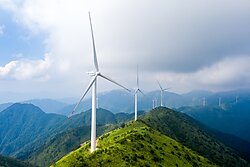-
Historically clothes have been very expensive. Thanks to globalization, almost everyone in the world now has abundant clothing in many styles.
-
A globalized apparel industry raises wages and supplies low-income families with affordable clothes.
-
Clothing abundance may have environmental impacts, but new technology was the solution to clothing scarcity, and it will continue to help us mitigate the downsides.
Introduction
Plentiful cheap clothes are a triumph of innovation and markets. Most of human history has been characterized by privation and low-productivity toil. As one American sharecropper exclaimed in John Steinbeck’s Depression-era novel The Grapes of Wrath, “We got no clothes, torn an’ ragged. If all the neighbors weren’t the same, we’d be ashamed to go to meeting.”
Today, things are different. People in wealthy countries can order a new outfit for less than a day’s wages. We enjoy new styles and trends that were once reserved for the ultra-rich. Even our poorest are rarely lacking sufficient clothes and shoes.
Much of this abundance is owed to globalization. Clothing is so plentiful that unwanted new garments are piling up on the beaches of Ghana. African consumers can no longer absorb the quantities shipped to them by rich ones, so they choose the styles they love and discard the rest.
There are, however, critics of these trends, especially the recent phenomenon labeled “fast fashion,” the rapid production of inexpensive, trendy clothing that is quickly made available to consumers, often resulting in short product life cycles. The United Nations Economic Commission for Europe called the fashion industry an “environmental and social emergency” because clothing production has roughly doubled since the year 2000. Their main concerns are fast fashion’s environmental impact and working conditions. As Figure 1 shows, Americans are indeed consuming more clothing.
Is apparel a menace? In short, no. Globalization of the clothing industry has been good for the United States and the world.
Clothing Abundance and Globalized Fashion Provide Myriad Benefits
From the runways of Paris and Milan to the shops on Savile Row and the streets of Brooklyn, fashion has long been global and one of the ways people around the world can learn from one another. It used to be, however, that most fashion was reserved for the elite while common folk got by on a few well-worn staples. The recent explosion of cheap mass-produced clothes is a testament to the power of specialization and exchange on a global scale. Elizabeth Cline wrote, “If you ever wonder how we went from living in a world of relative clothing scarcity to feeling like we’re swimming in the stuff, ponder no further than China.” One city in China produces most of the world’s socks, over 20 billion pairs a year. This works because of an integrated international supply chain. It was only with the expiration of the Multifiber Arrangement in 2005 that the global textile and apparel trade was fully opened, following decades of gradual liberalization efforts through agreements such as the Agreement on Textiles and Clothing negotiated as part of the Uruguay Round of the General Agreement on Tariffs and Trade (the GATT).
Critics sometimes ignore the social benefits of cheaper clothes that weigh against its costs. Globalization has increased the variety of clothes we can choose from, and we can express ourselves in almost any way imaginable. What The Economist calls “mass customization” is fun. A fashion influencer summarizes the attitude of fans of low-budget brands like Shein: “People deserve to have nice things.… A lot of us that work regular 9‑to‑5 jobs can’t afford $2,000 shoes.”
But having plenty of textiles is about more than just people looking good or buying new dresses. Abundance means that children have winter hats and burn victims have bandages. And the global nature of fast fashion fosters economic integration and understanding. The exchange of fashion ideas creates a merging of cultures as designers draw inspiration from different traditions and consumers embrace trends from around the world. Fast fashion has the potential to democratize new trends and ideas, making them accessible to a broader demographic.
There are also other ways that cultural exchanges happen. Global supply chains bring people together to solve problems and foster an exchange of businesspeople to run these supply chains. For-profit clothing businesses achieve the goals of cultural nonprofits such as the Rhodes Trust and the Olympic Foundation for Culture and Heritage. And thanks to the internet, any person in any country can share what they love with a global audience of fans. This is what a rich globalized world looks like.
Textiles Trade Supports Better Jobs—Here and Abroad
Critics also misunderstand that what might be considered a sweatshop in the United States is an improvement over the real-world alternatives available in poorer countries—a step that Americans themselves took a century ago.
Dana Thomas sums up the sentiment toward trade and technology among fast-fashion critics in her book Fashionopolis:
Since the invention of the mechanical loom nearly two and a half centuries ago, fashion has been a dirty, unscrupulous business that has exploited humans and Earth alike to harvest bountiful profits. Slavery, child labor, and prison labor have all been integral parts of the supply chain at one time or another—including today. On occasion, society righted the wrongs, through legislation or labor union pressure. But trade deals, globalization, and greed have undercut those good works.
The implication that child labor is the result of mechanized manufacturing is backward. Children today have been largely freed from production jobs because of the wealth created by machines and globalization. It is not primarily legislation that creates safer jobs but rather economic growth.
Preindustrial women spent much of their lives spinning thread. In the United States today, it would be illegal to pay as little as these women earned for their labor. The reality was that these women were not very productive because they were working with poor technology, and yet they did the work because it was their best option. Machines and synthetics allow us to produce more textiles with less labor.
Another common complaint is that Western corporations outsource manufacturing to low-wage Asian countries and reduce the number of jobs in rich countries. But this story is incomplete. Multinational corporations have moved some manufacturing operations abroad. Figure 2 indicates that fewer clothes are made in the United States, meaning most of the clothes represented in Figure 1 were imported. Thus, some manufacturing jobs in fashion have moved from domestic producers to lower-cost factories in Asia. However, these jobs might have been offshored even earlier if regulations had allowed, because the United States currently specializes in high-tech and high-skill production.
In The Fabric of Civilization, Virginia Postrel reports on one of the few plants in the United States today that manufactures thread. With the latest technology and only 120 employees, the plant can produce 9 million pounds of yarn per year. Postrel estimates that each worker at this plant in Georgia produces an amount of yarn that would have taken a woman in the Middle Ages three centuries to spin.
Technology has forced workers all over the world to adapt, and although technology can lead to fewer human jobs in the short run—no one is happy when robots take our jobs—that is ultimately the only way out of everyone being stuck in low-paying work. Furthermore, the United States’ fashion-jobs story is one of both destruction and transition. According to the Bureau of Labor Statistics, today there are over a million American jobs in fashion-related industries. In addition to hundreds of thousands of retail jobs, multinational firms employ designers, marketers, educators, and journalists. Figure 3 shows a sample of remaining fashion-related jobs in America. As shown in new research by Teresa Fort and others, American multinational firms with offshore manufacturing operations, such as Oregon-based Nike, tend to have more of these “knowledge jobs” here in the United States. Many also have domestic manufacturing operations.
Factories dubbed sweatshops are best understood from a historical perspective. Whether speaking of England in 1830 or Vietnam today, garment manufacturing has typically been characterized by long hours and intensive manual labor. Sweatshops are problematic for Westerners because, in addition to concerns about unpleasant conditions, the wages are low. And sometimes cheaply constructed factories lead to injury or even death. In 2013, the Rana Plaza garment factory collapsed in Bangladesh, killing over 1,100 people; Fashionopolis contains interviews with survivors who saw coworkers die. In response to this tragedy, new safety guidelines were instituted, and fortunately, there have been no mass-casualty events since then. The tradeoff is that the stricter standards resulted in fewer jobs in garment factories in Bangladesh.
In 1998, the year that American students founded United Students Against Sweatshops (USAS), per capita gross domestic product (GDP) in Bangladesh was estimated to be under $500. Most of the population lives in poverty, experiencing health crises and premature deaths that go with material lack. Yet recently the nation has undergone what some might call a development miracle, with per capita GDP rising to $2,500. This rapid economic growth in Bangladesh is closely linked to garment exports, a main source of income for the country. To protect this source of revenue, the government has created rules that support garment manufacturers. From the perspective of people inside the country, this is a link to the world economy that employs millions of people. Humans have been voting with their feet for hundreds of years, indicating a preference for factories over subsistence farming and rural life. Economic development requires moving up the chain in productivity.
Dana Thomas celebrates the opening (reshoring) of a sewing shop in Alabama, but most Americans do not want to sew for a living. The few businesses manufacturing clothes in the United States employ mostly immigrants and refugees who have few other opportunities. Reshoring low-productivity work in rich countries is not a guaranteed way to improve outcomes. If the goal is to generate a living wage for billions of people, then our focus should be on making stuff more efficiently, which can also be better for the environment.
Thomas paints a glowing picture of new British entrepreneurs who process thread and weave cloth near the sites of the early industrialized mills in Manchester, but this is not really a portrait of anti-globalism. These entrepreneurs would not be able to operate their high-tech machines without importing raw material and technology and computer parts. There is no such thing as “local” manufacturing.
One reason multinational firms initially set up manufacturing in China was that labor was cheap. It is not through legislation (which is avoided by subcontracting with illegal shops) that sweatshops are receding in China. Working conditions in Chinese factories are improving because of economic growth, and Chinese wages are rising quickly. Many of the jobs that were once in China have moved to Vietnam; today, the Wall Street Journal reports, those factories can’t find enough workers because young people would prefer to work in service industries.
This is a separate topic from sweatshops, but it is important to acknowledge that there is still slavery in the world. Walk Free estimates that there are tens of millions of enslaved people in the Asian and Pacific regions today. Although I would not advocate sanctioning manufacturers over low wages, I and other free traders support private boycotts and laws, such as Section 307 of the Tariff Act of 1930, targeting goods made from forced labor. For example, the US government is scrutinizing the Chinese fashion firm Shein over the issue of forced labor. To trade in the global economy, companies should have to follow such laws. But forced labor is different from the issue of poverty and low wages.
Indeed, activists for raising wages must be passionate advocates of sustaining and accelerating economic growth. That is the only way to generate enough income for tens of millions of garment workers in Asia and elsewhere. Elizabeth Cline defines a living wage as one that affords “food, water, housing and energy, clothing, health care, transportation, education and child care, as well as modest funds for savings and discretionary spending.” This is not a mandate to return to nature or retreat from globalization. Because trade increases wealth, in fact, this is a mandate for more globalization in the years ahead.
Can Global Fashion Become More Sustainable?
The desire to see poorer nations catch up to Western living standards may or may not conflict with the other concern about fast fashion: its impact on the natural environment. Producing and disposing of clothes affects the Earth. Well-meaning folks donate their used clothes instead of throwing them away. The good news is that clothing that cannot be resold as garments can find a second use as industrial rags. However, there are so many clothes that some donated garments end up in the trash, even if they’re transported to Africa to be looked at one last time. (Adam Minter provides a more optimistic view of the global trade in secondhand goods.) Most cheap clothes are made of plastic, which does not biodegrade like cotton.
Recycling entrepreneur Kerem Saral explained to me, “We are eating the stuff now that we took to Goodwill.” Americans’ unwanted clothes contain synthetic materials that enter the food chain as microplastics. At a global level, discarded garments do not all make it into lined landfills that corral garbage.
Scientists are studying microplastics and trying to determine whether they pose a health threat. Today we know that lead is toxic and that no amount is safe for humans. In the future, we might discover microplastics are so bad that we need to change our way of life, which for many people often includes disposable forks and shirts. It is difficult to determine the optimal level of textile production without clear facts about the effects of disintegrating polyester on human health. In recognition of the negative externality for the disposal of clothes, European governments are considering a new tax per garment.
For those concerned about discarded clothes, I propose three reasons for optimism about the future: information, innovation, and economic growth.
Information
Individuals, clothing brands, and governments are starting to react to new information on an unintended, unforeseen consequence of a recent increase in production: polyester littering the ocean. Minter’s practical suggestion is that clothes should be labeled by durability to combat the race to the bottom on quality. It can be hard for consumers to know in advance how quickly a pair of shoes will wear out, so this data would nudge people away from buying disposable fast fashion. In addition to more data, we need more intelligence to help get optimal clothes to consumers. Artificial intelligence (AI) tools are already helping brands produce only what will sell and helping sellers find buyers in secondhand markets. When people live close enough to make travel costs negligible, with the help of Facebook for coordination, they can exchange goods in a Buy Nothing group. Websites such as Poshmark.com make it easier to sell unwanted clothes and give people an incentive to recirculate.
Innovation
A pathway to cleaner fashion is technology, and we are already seeing innovations along several dimensions:
- Materials. Like lab-grown meat, lab-grown fibers are in the early stages but could generate cloth in ways less polluting than cotton farming or leather tanning. With continued advances in chemistry and biology, we might move away from harvesting raw materials on farms and shipping them for large-volume production runs in low-income countries.
- Production. The introduction of sewing-capable robots could disrupt the current model that created millions of manufacturing jobs in Asia. The International Labour Organization reports, “Prominent occupations in certain countries face extreme risks of automation. For example, in Cambodia, where garment production dominates the manufacturing sector, close to half a million sewing machine operators face a high automation risk.” The future might look like print-on-demand clothes made by highly paid technicians.
- Recycling. All garments eventually become unwanted, but clothes do not have to become garbage. Clothes are already recycled for use as industrial rags or insulation; a goal among fast fashion activists is to see more clothes recycled into raw fibers that could make new clothes. If it works, we could achieve what is known as “circularity.”
- Matching. Fabric is not scarce in America today, but attention is. AI can fill the attention gap and become a personal assistant for obtaining clothes, with the option of finding sustainable products. At the same time, technology could help or replace workers at organizations like Goodwill who are tasked with separating donated goods into piles for resale or recycling—a costly and time-intensive process. Smart robots powered by AI could scan donated clothes and direct them to a new buyer or an appropriate recycling plant. The gains from cheap decisionmaking would be high and the potential for harm through AI errors is limited. If AI-powered sorting is the future, then it could become efficient enough for people to sell their unwanted clothes to sorters, which would increase circularity compared to the donation model.
Economic Growth
The world is getting richer, and rich countries have more capacity to protect the environment—whether through information, innovation, or regulation. Already, some clothing brands are taking steps toward cleaner clothes. For example, financial backers for the Better Cotton Initiative are not consumers but rather multinational brands like Adidas and Walmart. Patagonia is one of the leading brands known for trying to avoid the fast fashion race to the bottom on quality. They use mostly recycled materials and organically grown cotton, and they accept certain returned Patagonia gear in exchange for store credit. Leveraging their data and scale, funded by wealthy consumers who can afford to be more conscientious, brands can make changes to reduce waste.
Thanks to these three factors, much of the world is becoming cleaner and greener, even as we consume more stuff. Just as cars today have cleaner emissions, we can expect improvements for fashion too—to get more clothes from fewer natural resources. And globalization will play an important role, fueling the growth needed to afford better conditions and develop better technologies while fostering information-sharing and collaboration among the best minds in the world. Since globalization lowers the cost of producing any good, we would need it to maintain an abundant supply of clothes in the face of new and costly environmental regulation (similar to the regulation of plastic bottles).
Conclusion
For millennia, clothing ourselves was a struggle that consumed much of our time. Today an American teenager with a minimum-wage job can summon a new outfit from an app.
To describe modern fashion as a disaster fails to recognize the improvement in well-being from cheap, globalized textiles. After Alden Wicker conducted an exhaustive survey on the cutting edge of recycling and green tech for apparel, his conclusion was, “We need to make and buy less stuff. Does anyone have an innovation for that?” Someone from the past would never believe that we are struggling to have fewer clothes. Be happy that these are our new problems.
Globalization is part of the solution to environmental concerns and poverty wages rather than the primary cause of those problems, as some fast fashion critics have claimed. The mass production of the world’s socks all in one place might actually be better for the environment than individual plants in multiple cities, and reshoring could deny some of the world’s poorest people an established avenue out of abject poverty. Achieving higher wages for workers and a cleaner Earth requires highly efficient manufacturing, and globalization enables not only cheaper production but also the proliferation of ideas to solve real problems. In certain cases, to alleviate the dumping of plastic in places other than landfills, new regulations might be enacted; however, it will take a rich world to enforce them.
We innovated our way to making clothes plentiful and cheap. Now we can get smarter about reusing fibers and sorting the garments we have. AI might help us achieve more circularity and less waste in the apparel industry, where the primary constraint seems to be human time and attention.
Part of the upset over fast fashion is symptomatic of a false doomer eschatology in which the world cannot get better. In the good future, clothes can be plentiful and cheap and green.

This work is licensed under a Creative Commons Attribution-NonCommercial-ShareAlike 4.0 International License.














